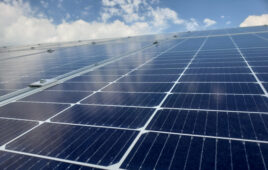By Hanan Fishman, president, Alencon Systems
One logical target for coupling batteries with solar is hiding in plain sight: The many gigawatts of already installed PV resources. Duke Energy, one of the largest utilities in the nation, based in North Carolina, is seeking to tap into this opportunity. Duke Energy has installed energy storage into some of its existing PV arrays and plans to continue these integrations in the future.
“As more renewables come onto to a circuit, the need to optimize that circuit, from the need to provide voltage and frequency stabilization is going to increase. One of the easiest ways to do that is to utilize energy storage and allow that storage to interact with solar,” said Tom Fenimore, business development for Duke Energy. “Providing grid stability is an explicit part of our charter as a regulated utility.”
When looking to add storage to existing PV assets, system owners like Duke Energy have two options — AC or DC coupling. AC coupling of solar and energy storage is achieved when the solar panels and the batteries are connected on the AC side of the inverter — “behind the inverter.” By contrast, in a DC-coupled topology, solar and storage are connected on the DC side of the inverter — “in front of the inverter.”
While there can be viable reasons to use the AC- or DC-coupled approach for different solar + storage applications, when it comes to installing storage into existing PV systems, Fenimore believes DC coupling presents some very compelling advantages over AC coupling.
One of the major advantages DC coupling offers as a technique for integrating storage into existing PV plants is the opportunity to take advantage of the trend of ever-increasing DC:AC ratios. The DC:AC ratio refers to the amount of installed PV panels relative to the AC nameplate of the inverter, which is dictated by the size of the AC interconnect to power distribution grid.
In recent years, due the falling price of PV panels and improved inverter technology, there has been a trend to increase DC:AC ratios. Years ago, PV plants were designed with modest DC:AC ratios, typically between 1.05 and 1.1. In more recent years, DC:AC ratios for larger-scale solar plants have increased from anywhere between 1.5 to 1.8 DC:AC. There are some PV inverters even capable of handling DC overbuilds of two-times the PV to the plant’s rated AC capacity. Learn more about DC:AC ratio considerations from this recent article.
All that PV overbuild leads to the possibility of extensive amounts of potential clipped energy — PV production that is curtailed by the inverter when PV generation exceeds the inverter’s power rating. The DC coupling technique of combining solar and storage allows that excess generation to be diverted into a battery during periods of overproduction. This captured generation can then be discharged later in the day or in the evening to smooth out the production from a PV plant, turning an intermittent energy resource like solar into a truly dispatchable one. For regulated utilities like Duke Energy that contract with millions of end users to assure the lights turn on whenever they flip a switch in their home or business, being able to accurately control the dispatch of generation capacity is critical.
In addition to the opportunity to capture what might otherwise be clipped (thrown away) energy, DC coupling also offers a system owner some unique financial benefits. According to current government regulations, energy storage can only be claimed under the investment tax credit (ITC) when charged directly from PV.
“The key to successfully installing energy storage is doing so with favorable tax or other financial benefits,” Fenimore said. “Once we figure out how to do that as an industry with regularity, we’ll really see the needle move. One of the challenges we’ve had with storage is capitalizing on investment tax credits. DC coupling allows that to happen more easily than AC coupling because we are only able to charge the battery from the solar. Doing so makes it a clear-cut case from a financial perspective where the kilowatt hours charging the battery are coming from.”
As more PV comes onto the electrical grid, there will be a greater need and incentive to pair batteries with existing PV resources to assure the reliable operation of the utility grid and maintain the viability of clean sources of generation.






How do you add DC-couples storage to an existing field? you don’t enough physical space.